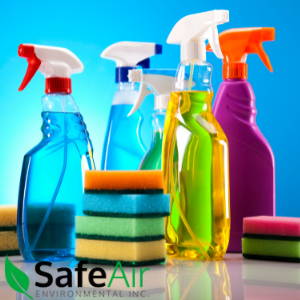How Harsh Chemical Products Can Affect Indoor Air Quality
Posted in Air Quality, on July 06, 2021
 For some of us, it just isn’t clean unless it smells clean — in fact, bad smells are the top reason people book indoor air quality testing! But before you revel in the lemony scent and admire your clean kitchen, you should be aware that some of the most common brands of cleaning products can harm your health. You may be surprised to learn that air quality testing picks up many of the common Volatile Organic Compounds (VOCs) found in products for the kitchen, bathroom, and floors.
For some of us, it just isn’t clean unless it smells clean — in fact, bad smells are the top reason people book indoor air quality testing! But before you revel in the lemony scent and admire your clean kitchen, you should be aware that some of the most common brands of cleaning products can harm your health. You may be surprised to learn that air quality testing picks up many of the common Volatile Organic Compounds (VOCs) found in products for the kitchen, bathroom, and floors.
What Are VOCs?
VOCs are chemical particles that evaporate at room temperature. If you’ve ever cut into a lemon and enjoyed the fresh scent, then you’ve experienced a natural VOC first hand! The problem with VOCs is that not all are as harmless as a lemon — chemical VOCs are known to cause eye and nose irritation, shortness of breath, headaches, and even nausea. Concentrated or long-term exposure to VOCs may even be a factor in cancer or damage to organs like the liver and kidneys.
What To Avoid in Cleaning Products
You’re right to be wary about how VOCs in cleaning products are affecting your indoor air quality. While the only way to know for sure is to have indoor air quality testing, you can be proactive by avoiding some of the biggest culprits when shopping for your next bottle of disinfectant or floor polish.
Some of the ingredients that SafeAir suggests you avoid include:
Bleach
Chlorine bleach (which is found in many brand-name products like Clorox) is a terrible substance to use in your home. It can off-gas chloroform or methyl chloroform, both of which have neurological effects and can cause dizziness, nausea and decreased blood pressure. It can also react with other cleaners to create hazardous by-products.
Fragrances
An increasing number of people are reporting allergic reactions to fragrances and scents. Avoid air fresheners or scented products, and re-wire your expectations when it comes to what smells ‘clean’ — the cleanest space shouldn’t have ANY smell at all.
Pressurized Sprays
Cleaners that come in aerosol cans release tiny particles at high speed. This makes it easy to apply but also very easily absorbed by your lungs and mucous membranes. Some of the VOCs found in pressurized glass and floor cleaners include toluene, ethylbenzene, camphene, formaldehyde, and tetrachloroethylene.
Safer Options for Cleaning Products
The first step to making sure that your cleaning products are safe is simple: just read the label. Many products these days are marked as low-VOC, fragrance or bleach-free, or as devoid of chemical irritants and flammables — choose those products to improve your indoor air quality.
But just because a product is labelled green doesn’t mean it can’t still be harmful — many of the ingredients in cleaning products have scientific names that are challenging to understand to the average person. We like to recommend checking out the EWG’s Guide to Healthy Cleaning https://www.ewg.org/guides/cleaners/ to help you decode some of the more esoteric names.
Several organizations offer safety standards and labels that make your decisions easier, too — the Green Seal certification program ensures products meet a set of safety criteria, including toxicity, manufacturing, and indoor air quality effects.
And then there’s always the old standard — for thousands of years, humanity has survived by using plain old soap and water and common household ingredients like baking soda and vinegar to clean up.
How to Maintain Indoor Air Quality While Cleaning
If you’ve just stocked up on cleaners or still have half a bottle left, there are ways to improve your indoor air quality while using them. Some of SafeAir’s top tips include:
- Avoid using cleaners in small or enclosed spaces with poor ventilation
- Let in lots of fresh air! Keep the windows open or run fans when using products that contain VOCs.
- Store cleaning products out of reach of children and pets and in a container that prevents leaks or spills.
Learn More About Your Indoor Air Quality
The best way to know what sorts of chemicals, pollutants, or irritants affect your home is to book professional air quality testing. At SafeAir, our indoor air quality tests look at your home at both a micro and macro level, assessing both the exterior and interior for different factors that affect indoor air safety.
Whether you have general concerns or specific questions about mold, radon gas, asbestos, or lead, SafeAir is one of the GTA’s leading indoor air quality specialists. With more than a decade of experience assessing homes and businesses, we’ve helped thousands of families improve the safety of their homes through indoor air quality testing. To learn more about our services, reach out to our team through our contact page.

